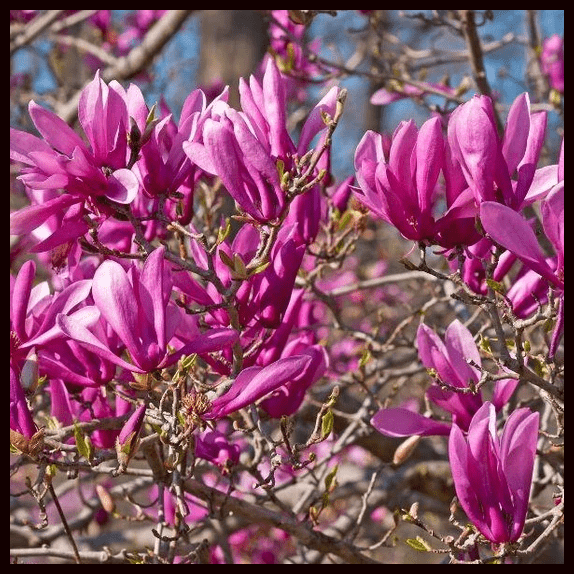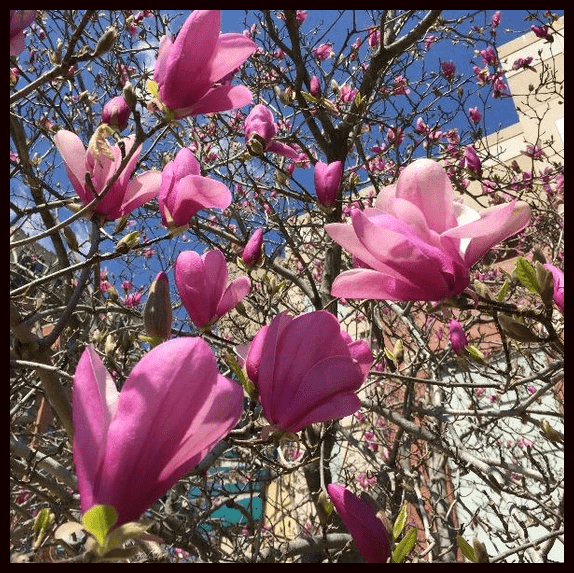Welcome to our guide on the Ann Magnolia Tree, a captivating ornamental tree that graces outdoor spaces with its elegant beauty. Explore the characteristics that make the Ann Magnolia a favorite among gardeners and discover how to cultivate and care for this enchanting tree in your own garden.

Growing Outdoors
The Ann Magnolia Tree, scientifically known as Magnolia ‘Ann’, is a deciduous shrub that blossoms with breathtaking flowers. Here’s how it flourishes in outdoor settings:
1. Flowering Splendor:
Ann Magnolia is celebrated for its vibrant, tulip-shaped flowers that appear in shades of deep purple-red. These blossoms emerge in early spring, providing a stunning display before the arrival of leaves.
2. Size and Shape:
This magnolia variety typically reaches a height of 8 to 10 feet with a similar spread, forming a compact, rounded shape. Its manageable size makes it suitable for various garden spaces, including small yards and landscapes.
3. Cold Hardiness:
Ann Magnolia is hardy in USDA zones 4-8, making it resilient to colder temperatures. It thrives in climates with distinct seasons and is an excellent choice for regions with chilly winters.

Care Instructions
Ensuring the health and vitality of your Ann Magnolia Tree involves paying attention to its specific care requirements:
1. Sunlight:
Plant Ann Magnolia in a location with full to partial sunlight. Ensure it receives at least 6 hours of sunlight daily for optimal flowering and growth.
2. Soil Conditions:
Provide well-draining, acidic to neutral soil for your Ann Magnolia. Adding organic matter to the soil at planting time can enhance its fertility.
3. Watering:
Keep the soil consistently moist, especially during the tree’s establishment period. Once established, Ann Magnolia is somewhat drought-tolerant, but regular watering is still essential during dry spells.
4. Pruning:
Prune your Ann Magnolia tree in late spring or early summer after it has finished flowering. This helps shape the tree and encourages a more compact and bushy form.
Planting Directions
Follow these planting guidelines to ensure a successful establishment of your Ann Magnolia Tree:
1. Site Selection:
Choose a planting location that receives the right amount of sunlight and has well-draining soil. Ensure there is enough space for the tree to reach its mature size without overcrowding.
2. Digging the Hole:
Dig a hole that is twice as wide as the tree’s root ball but just as deep. Loosen the soil around the hole to facilitate root growth.
3. Planting:

Place the Ann Magnolia tree in the center of the hole, making sure it sits at the same level as it did in its nursery container. Backfill the hole with soil and water thoroughly.
4. Mulching:
Apply a layer of organic mulch around the base of the tree to retain moisture, suppress weeds, and regulate soil temperature.
5. Watering After Planting:
Water the newly planted tree generously to help it settle into its new environment. Provide additional water as needed during the first growing season.
By following these care instructions and planting guidelines, you can enjoy the splendid beauty of the Ann Magnolia Tree in your outdoor space. Revel in the charm of its vibrant blossoms and make this graceful tree a focal point in your garden oasis!
Ann Magnolia: A Beautiful and Resilient Bloom
The Ann Magnolia (Magnolia x ‘Ann’) is a stunning and highly sought-after deciduous shrub that has captured the admiration of gardeners and landscape enthusiasts worldwide. Known for its breathtaking spring blossoms and robust adaptability, Ann Magnolia is a hybrid variety that stands out among magnolias for its prolonged bloom period, cold hardiness, and compact growth habit. This article delves into the history, characteristics, care requirements, and benefits of incorporating Ann Magnolia into landscapes and gardens.
History and Origin
Ann Magnolia is part of the “Little Girl” series of hybrid magnolias, which were developed in the 1950s at the U.S. National Arboretum by Francis DeVos and William Kosar. These hybrids were specifically bred to produce late-blooming magnolias, reducing the risk of frost damage that often affects early-blooming species. Ann Magnolia resulted from the crossbreeding of Magnolia liliflora ‘Nigra’ and Magnolia stellata ‘Rosea.’ The outcome was a small, hardy tree that boasted vibrant purple-red flowers, extended blooming periods, and enhanced resilience in colder climates.
Physical Characteristics
Ann Magnolia is a multi-stemmed shrub or small tree that typically grows between 8 to 10 feet tall, with a similar spread. Its compact growth habit makes it an excellent choice for small gardens, urban landscapes, and even container planting. The most striking feature of Ann Magnolia is its magnificent flowers, which appear in early to mid-spring. These blossoms are deep pink to reddish-purple, cup-shaped, and emit a subtle fragrance that attracts pollinators like bees and butterflies.
Unlike some magnolias that bloom all at once, Ann Magnolia enjoys a prolonged flowering season. After the initial heavy bloom in spring, the shrub may continue to produce sporadic flowers throughout the summer, adding visual interest for an extended period. The foliage is equally appealing, with lush green leaves that turn a golden-bronze shade in the fall, enhancing seasonal beauty.
Growing Conditions and Care
Sunlight and Soil Requirements
Ann Magnolia thrives in full sun to partial shade. Ideally, it should receive at least six hours of direct sunlight daily to promote optimal blooming. While it can tolerate a variety of soil types, it prefers well-draining, slightly acidic to neutral soil enriched with organic matter. Heavy clay or overly sandy soils should be amended with compost to improve drainage and fertility.
Watering and Mulching
Regular watering is crucial, particularly during the establishment phase. The soil should remain consistently moist but not waterlogged. Once established, Ann Magnolia is relatively drought-tolerant, though it benefits from occasional deep watering during extended dry periods. Applying a 2-3 inch layer of mulch around the base of the plant helps retain soil moisture, regulate temperature, and suppress weeds.
Pruning and Maintenance

Ann Magnolia requires minimal pruning, making it an easy-care plant. Pruning should be done right after the main flowering period to avoid removing potential flower buds for the following season. Light pruning can help maintain the desired shape, remove dead or damaged branches, and encourage air circulation.
Pest and Disease Management
Ann Magnolia is generally resistant to most pests and diseases. However, it may occasionally experience issues with scale insects, aphids, or fungal infections like powdery mildew. Regular inspection, proper spacing, and good air circulation help minimize these risks. If necessary, horticultural oil or insecticidal soap can be used to manage pest infestations.
Landscape Uses and Benefits
Aesthetic Appeal

Ann Magnolia’s vibrant flowers and compact form make it a versatile addition to various landscape settings. It works beautifully as a specimen plant, focal point, or foundation planting. Additionally, it pairs well with other spring-blooming plants, creating a breathtaking seasonal display.
Wildlife Attraction
The fragrant flowers of Ann Magnolia attract beneficial pollinators, including bees and butterflies, contributing to local biodiversity. Birds may also find shelter in its branches, adding an element of natural beauty and ecological value to gardens.
Adaptability
One of Ann Magnolia’s most appealing qualities is its adaptability. Unlike some magnolia species that struggle in colder regions, Ann Magnolia is hardy in USDA zones 4-8. Its ability to withstand late frosts and adapt to various soil conditions makes it a reliable choice for gardeners across diverse climates.
Environmental Benefits
Beyond its visual charm, Ann Magnolia plays a role in improving air quality and reducing erosion. The tree’s root system helps stabilize soil, preventing runoff, while its foliage absorbs carbon dioxide, contributing to a healthier environment.
Conclusion
Ann Magnolia is a remarkable plant that offers beauty, resilience, and ease of maintenance. With its enchanting blossoms, prolonged bloom period, and adaptability to different environments, it remains a favorite among gardeners and landscapers. Whether used as a focal point, an accent in a mixed border, or a charming addition to a compact garden, Ann Magnolia’s elegance and hardiness make it a rewarding choice for any landscape. By understanding its care requirements and potential benefits, gardeners can fully appreciate and enjoy the splendor of Ann Magnolia for years to come.

